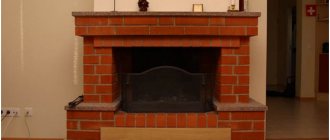What is the difference between a built-in refrigerator and a regular one?
A built-in refrigerator is a special design that differs from the classic model in some details and characteristics. The main distinguishing feature of such a device is that it requires a special cabinet to accommodate it. The dimensions of the furniture attribute are carefully selected for the specific model of the refrigeration unit. It is manufactured according to the dimensions specified in the product passport. It is very important that the depth of the cabinet and refrigerator are identical. The equipment is installed on the bottom of the cabinet; in some cases, it is recommended to install the device in a furniture module without a bottom.
The refrigerator doors are connected to the furniture doors using special clamps. It should be noted that the design of a conventional refrigeration unit does not allow this. Also, the built-in system is characterized by increased thermal insulation, good ventilation, and it meets the highest fire safety requirements.
Advantages and disadvantages of installing a refrigeration unit
The advantages of refrigeration equipment hidden behind a furniture door include:
- Aesthetic interior. Not all interior styles can accommodate appliances with an enameled or steel surface. It looks especially ugly in classic, ethnic interior styles. By hiding this necessary element of the kitchen behind the facade, we can create a unique design in which every detail corresponds to the overall style and effectively fits into the furniture ensemble.
In addition, electrical wires will be securely hidden, which is also very important for creating an attractive environment. - Ergonomics . The equipment can be placed at any height and anywhere. This is very important for the correct organization of the “work triangle”. To reduce cooking time, experts recommend minimizing the distance between the three main elements of the kitchen: the refrigerator, stove and work surface. Hidden technology allows you to create an ergonomic space and rationally use every corner.
- Silence . Due to the fact that the unit is located in a box, the noise level is significantly reduced. This is also facilitated by reliable fixation of the equipment to the body, as reproduced vibrations are damped.
- Economical . As you know, the design of the unit is characterized by increased thermal insulation. This is facilitated by a protective layer that isolates the device from the external environment. Thanks to this, the refrigerator operates in economical mode and consumes less energy.
- Easy care . Hidden side walls and wires do not need to be cleaned, which significantly saves time on maintaining the kitchen appliance.
- Large selection of models . The buyer is offered various product variations to choose from. Household appliances can be built under the countertop, mounted in an island or other place convenient for use. There are various models of devices: with a bottom, side, top freezer or without it at all. Each buyer has the opportunity to select individual equipment parameters and its configuration.
Unfortunately, there are some disadvantages of “hidden” appliances, which should also be taken into account when planning your kitchen space:
- Small useful capacity of internal chambers . Compared to conventional models, built-in ones have a smaller capacity with the same dimensions of the equipment.
- Inconvenient controls . Settings cannot be adjusted when the door is closed.
- Impressive value. Not only does the device cost more, you will also have to pay more for installation of the product.
Basic installation rules
There are rules that determine how to properly install a refrigerator not only in the kitchen.
When installing, they cannot be ignored, as thanks to them the device will last longer while maintaining functionality..
- It is necessary to maintain a distance from the heating elements of heating devices. This can be: a gas or electric stove, oven, boiler, radiators, batteries and other household units that emit heat. Because of this, the refrigerator compressor will turn on more often, which will lead to its premature failure. The distance to the stove should be at least 30 cm, and to the battery at least 50 cm.
- The refrigerator can be installed in rooms with a temperature of no lower than 16 and no higher than 38 degrees. Room humidity should not exceed 75%.
- It is not advisable to place the device near a window to avoid direct sunlight.
- Provide air circulation. The minimum clearances required for the normal functioning of the cooling system are 10 cm on each side. Some refrigerators are less demanding on ventilation gaps, so precise information on them can be found in the instructions for a specific device.
After following these recommendations, you should install the unit level using twist-out legs, and to prevent it from moving spontaneously due to vibration, put special rubber bands on them.
Where to connect
Connecting the refrigerator is an important stage during installation, on which the service life depends. Before turning on the cord, you must make sure that the socket is installed well and does not have exposed contacts, otherwise it must be replaced.
You may be interested in: How to protect a refrigerator from batteries
If the factory cord is not long enough, you can use a surge protector or other extension cord. It is important here that the filter is not overloaded with other household appliances.
Important! Before connecting the refrigerator to the network, you need to remove all kinks in the cord, this will minimize its failure.
Where to put the refrigerator
There are no restrictions on where to place the refrigerator; you can use any floor covering, at least the manufacturers do not prohibit this. But to reduce the vibration that comes from a running engine, it is better to install the device on special anti-vibration stands. You can buy them at any hardware store.
The second option is to install it on a special rubber mat that will absorb vibration waves.
Important! The main thing during installation is to level the refrigerator in all planes. All legs must touch the support and the appliance must not swing when the doors are opened.
Types and models of built-in refrigerators
The modern market of household appliances offers many options for kitchen “helpers”. Depending on the location of the unit relative to the furniture body, the following types of devices are distinguished:
- Fully built-in . The appliances are hidden behind the facade of the kitchen; the presence of a refrigeration unit can only be guessed by a special grille.
- Partially hidden.
The device is completely “recessed” in the box, only the doors or control panel are visible from the outside.
Depending on the number of cameras there are:
- Single chamber models . These are products without a freezer, or it is located inside the main chamber. Usually these are small models that can be easily integrated into the bottom row of a kitchen set. Often a dishwasher or washing machine is installed at this level.
- Two-chamber . These are separate refrigerator and freezer compartments, they are equipped with separate doors.
- Multi-chamber . They consist of several sections, in each of which the optimal temperature is set. Typically, cameras are not located vertically, but next to each other. The doors of such models open in the same way as the doors of a hinged cabinet.
Depending on the location of household appliances, there are models designed for installation:
- Under the table top . An ideal solution for small kitchens where every centimeter plays a decisive role. To save space, the unit is mounted under the dining table. This non-standard solution ensures a comfortable and convenient pastime in the kitchen.
- On the work surface . Usually these are small-sized devices, the height of which does not exceed 85 cm. As a rule, offices, cottages and small kitchens are equipped with such devices.
- In the closet . The most common type is suitable for kitchens of various sizes and configurations. It is a column that fits perfectly into the overall style of the interior.
- On the island . An interesting option that is preferred by owners of spacious kitchens. In this case, all equipment is located in the center of the room. This is where the work area and washing area are organized. This area is also used as a bar counter. It is very convenient to place a refrigerator here in order to provide convenient and quick access to food and drinks.
- In a niche . The method is suitable for rooms where there is a well-ventilated corner. In this case, all work is carried out at the initial stage of repair.
Refrigerator color
It is always better to choose a refrigerator that matches the color of your kitchen unit. Unfortunately, this opportunity is not always available, because the palette of kitchen furniture is a hundred times larger than the shades of refrigerators.
It is also a good option to place a refrigerator that is very different in color from the interior as a bright spot of color. In this case, it is worth adding 2-3 more details of the same shade.
Requirements for installing a built-in refrigerator
The work of installing a refrigeration unit involves installing it in a special cabinet. As a rule, it is part of a kitchen set and is made in the same style. The box is equipped with a front door, which is attached to the unit door in such a way that when one opens, the other one also opens.
However, simpler designs of pencil cases are available, the doors of which open independently of the doors of the device. The pencil case can be made independently; in this case, certain requirements must be met:
- To avoid overheating of the device, you should organize unimpeded removal of warm air. That is why the back of the box is made open.
- The distance between the walls of the household appliance and the furniture should be several centimeters.
- Ventilation holes are equipped at the bottom of the structure.
When it comes to choosing a suitable location for installation, we follow the following rules:
- We install the device relative to the wall so that there is a distance between the back wall and the partition necessary for normal air circulation.
- Opening and closing doors must be free, without any obstacles.
- Parts of the structure must not come into contact with elements of the heating system or other heat sources.
Alternative places to install the refrigerator if it does not fit in the kitchen
Most often, you have to resort to alternative solutions when there is very little space in the kitchen, and you don’t want to give up any pieces of furniture or appliances. In this situation, you can consider placing the refrigerator outside the kitchen walls. The big advantage of this solution is saving space, but on the other hand, using the refrigerator is no longer so convenient, because every time you have to leave the room and go to another place to buy groceries.
The refrigerator should be located in an accessible and convenient place.
Refrigerator installed in the hallway
In small apartments it happens that there is no room for even a small refrigerator in the kitchen. Most often, the closest space is the corridor. This is where the refrigerator is often installed if there is not enough space in the kitchen. If the refrigerator was originally located in the kitchen, and there was a need to move it into the hallway, then first you need to remove the door so that it does not interfere with the transfer process.
Most apartments have small kitchens, so in order not to clutter up a lot of space, the device should be chosen in small sizes.
In some homes, the size of the kitchen simply does not allow installing even a small refrigerator in it. In this case, it is taken to the nearest room - most often to the corridor. If there is a connecting door between the living room and kitchen, you can install it in the next room.
It is only important to remember that the refrigerator should not stand close to the wall; it is important to leave some free space so as not to disturb the air exchange processes.
Additional information: This arrangement is rather a necessary measure, when there are absolutely no options left, and is suitable as a last resort. This is due to the fact that it is completely inconvenient to go to the corridor for groceries every time.
Is it possible to move a bulky unit onto the balcony?
Moving the refrigerator onto the balcony is not possible in every case. The fact is that the refrigerator does not tolerate both heat and cold in the space very well, this directly affects its performance characteristics. Most often, only residents of the south of the country can bring such a unit onto the balcony, because it is practically impossible to find cold weather there. But you should also be afraid of overheating.
If the temperature outside is above 30 degrees, then the refrigerator located on the balcony will quickly fail.
However, there are models of a special climate class - they are not afraid of the cold. The same can be said about refrigerators equipped with a no frost system. But even in the case of such models, it is important that the balcony is insulated and protected from moisture using a ventilation system. Equipment must also be hidden from sunlight.
Instructions for installing a built-in refrigerator in a kitchen set
When performing work, we follow the following sequence of actions:
- We dismantle old equipment, if relevant. We try to work extremely carefully and carefully.
- We remove the purchased device from the packaging and remove the transport fasteners. It should be noted that when choosing the appropriate device, we must take into account the dimensions of the cabinet and the location of the fastening elements.
- We carefully inspect the device, then carry out a test run. We pay attention to how the motor works and check the functionality of the internal circuitry of the device.
- Pay attention to the direction in which the cabinet doors open. If practical, install the hinges on the desired side.
- We move the unit to its intended place, ensure vertical installation by changing the position of the adjusting elements located at the bottom of the product. It is advisable to use a building level for this purpose.
- To ensure a fixed position of the device, we use special foam pads and carefully select the required thickness. It is advisable to place them near the rear of the unit.
- We install the facade part and all the provided mounting elements. We check the smoothness of door opening, stability and reliability of the structure.
- We connect the unit to the electrical network and make sure it is fully operational.
It is recommended to perform the work if you have certain skills. If they are not there, then it is better to contact specialists who will competently and promptly perform all the actions. Otherwise, the work may result in complete failure and significant financial losses.











